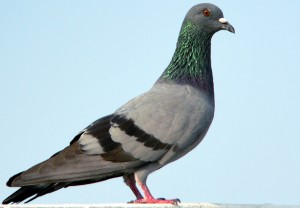
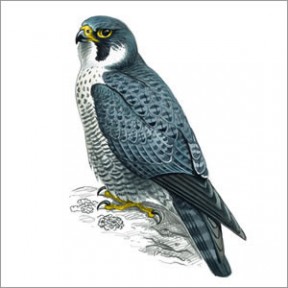
Evidence from 5000 year old Mesopotamian cuneiform tablets show clear images of pigeon domestication; however, it is likely that humans and pigeons were in close proximity much earlier than this making an earlier date for domestication more likely. (3) The majority of domesticated animals throughout history were first captured and kept by man as a food source, which seems to hint at a similar story for pigeons. Humans and rock pigeons would likely have been in close proximity due to a similar habitat, and the diet of pigeons which consists of mostly seeds, fruits and leaves may have led pigeons to move closer to humans that settled down began to grow their own crops. (4) As humans began to cultivate their crops 10,000 years ago, there is reason to believe that pigeons were likely domesticated by humans for food long before evidence of their domestication was discovered in Mesopotamia. (3) In addition, pigeons have relatively few natural predators, with birds of prey, namely the peregrine falcon, being the only major source of predation on wild pigeons. (3) This fact could have made it easy for humans to capture early pigeons because they did not typically associate fear with anything other than birds of prey. Additionally, pigeons that were nesting close to humans in order to take advantage of the abundant source or seeds and grains provided by human cultivation of plants would have provided an easy meal for humans who traveled from nest to nest collecting eggs and hatchlings. (3)
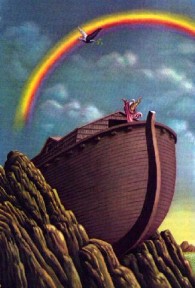
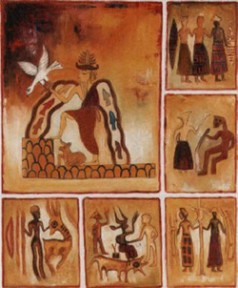
In addition to the cuneiform tablets, many other human societies have evidence of the use and/or domestication of pigeons. Clay images of pigeons have been found in excavation sites from 3000 years ago in Sumeria, Crete, Iraq and Egypt, and while the extent of role of the pigeon in these societies cannot be determined, evidence of the pigeon in these ruins does suggest that they must have had some purpose or meaning to these cultures. (3) One example of early use of pigeons for something other than a food source dates back to 1100 BC. Evidence of 57,000 sacrificed pigeons was discovered in Egypt which opened the door for pigeons as a religious symbol and icon. (3) Depictions of pigeons and doves can be seen from Christianity with a dove bringing Noah an olive branch to Islam with Mohammed receiving divine messages from the pigeon on his shoulders to Hinduism and Sikhism with various gods being depicted alongside doves and pigeons. (3)The pigeon, as well as the dove, which is also a descendent of the rock pigeon and therefore a close relative of the pigeon, has been associated with many different religions for thousands of years. One can only speculate as to why the descendants of the rock pigeon took over this role; however, many other domesticated species became religious symbols or icons based on their role in other aspects in the lives of humans from food to labor to transportation. It is possible that the pigeon and doves other roles in human societies perpetuated them into the realm of religion. Another plausible theory for the religious impact of pigeons and doves could come from their mastery of the air. Pigeons have been known to fly at heights of 6000 feet and reach speeds of over 90 mph. (3) It is possible that people interpreted pigeons coming down from these astonishing heights as coming down from the heavens. Thinking about this data this way does not require much of a jump to associate the pigeon as a messenger from the gods.
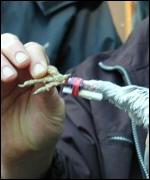
Another major use of pigeons in human society was for the delivery of messages. Pigeons have a very elaborate nesting and reproductive process and are known for being monogamous. Upon meeting, a male pigeon will go through a courtship routine consisting of strutting, bowing, and cooing. If the female decides that his display was sufficient, the pair will begin collecting nesting materials and build a nest. During this process courtship continues, and once the nest is complete, the female will couch to allow copulation. This whole process takes about a week, after which the first egg is laid followed by a second egg 48 hours later. Both parents take turns incubating the eggs until they hatch and then both parents begin to produce crop milk using the epithelial cells inside their crop. This milk is used to feed the baby pigeons for a few weeks until they are large enough to leave the nest and fend for themselves. About a week after the babies leave the nest, the male pigeon will begin courting the female again and the process starts all over. All of the steps must be performed in this order, otherwise the necessary hormone changes in the male and female pigeons do not occur, and no babies will be born. (Animal Behavior, Manning and Dawkins pg. 229-231) (5) It is uncommon among bird species for both parents to have such a large role in the reproduction process, and this is one of the reasons why pigeons make such excellent messengers. As you can see from the discussion of reproductive habits, pigeons are very attached to their significant other, and as a result, they will travel great distances to return to their mate. In addition, pigeons have an excellent sense of direction; however, there is some debate as to what feature it is that results in this extraordinary ability to travel hundreds of miles away from the nest and be able to find their way back. Some people claim that it is the pigeon’s ability to use Earth’s magnetic field to determine precise direction using specialized internal structures and neurons. (6)

Others maintain that it is the phenomenal vision of pigeons that allow them to navigate using landmarks, such as roads and large buildings, which they can see from the sky. Birds have specialized receptors that allow them to see not only the visible range of colors as humans do, but also some ultraviolet light. In addition they have receptors that allow them to better pick up motion and the placement of the various cones they possess in their eyes are spaced in such a way as to maximize their visual capabilities. These differences in the retinal structure of birds are likely a result of the fact that birds never had a nocturnal period in their history. Birds, having evolved directly from dinosaurs, gained an advantage over mammalian species that were forced to hunt at night when the dinosaurs were inactive. The lack of a large overlap between birds and dinosaurs saved birds from this nocturnal period and thus eliminated the need to develop better nocturnal vision. Nocturnal vision requires different structures than those required to see in the daylight, so where mammals were forced to give up some of their daytime vision in order to see at night, birds come from an evolutionary line working only to perfect vision during the day. (7) In addition, pigeons in particular are proficient at recognizing shapes from any angle. For example, humans are extremely proficient at recognizing shapes, such as letters, when presented to us as we normally see them; however, when the angle is changed, say the letters are turned upside down; we struggle to distinguish the letters or words. In pigeons this is not the case. Pigeons have shown that they take no longer to recognize a shape regardless of whether it is upside down or right side up. (5) So, between their desire to be with their mates and their excellent sense of direction, pigeons have an unrivaled ability to find their way home, which humans were quick to take advantage of. The use of the pigeon as a messenger dates back as far as 2500 BC, when the ruler of Sumer in Mesopotamia was said to have released two doves to tell of the end of the war with their neighboring cities. (3) From then on messenger pigeons became a staple for many different people and still continue to be used to this day.
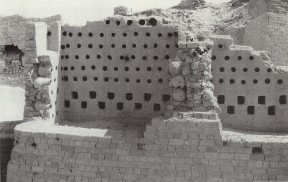
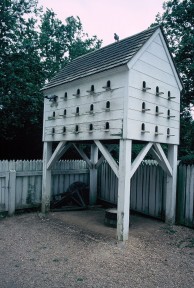
Evolution of the pigeon, facilitated by human desire for individuals that were best suited for delivering messages, resulted in the creation of the carrier pigeon. As described earlier, pigeons are very good with directions, and by selecting those birds that exhibited the greatest ability to fly over long distances back to their homes, humans, overtime, created the carrier pigeon of today. The carrier pigeons was used around the world for thousands of years as it was a quick and efficient means of sending short messages. One early example of the use of carrier pigeons relates to Athens and the first Olympics. Athletes from far and wide traveled to Athens to participate in the games, and in order to quickly notify their respective village of their success in an event, each participant brought a pigeon that could be released to quickly relay the good news. Pigeons were also used throughout history to relay messages about various details of wars from victories to new strategies to calls 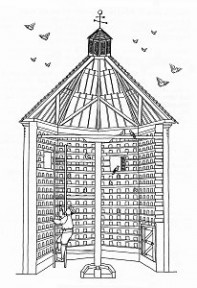 for reinforcements. (3) As the use of pigeons as messengers began to grow, methods to improve the process were put in place. In the 12th century AD, the cities of Damascus and Cairo constructed pigeon lofts and dovecotes which provided the pigeons with place to nest and raise their young as well as protection from predators, shelter from the elements, and in many cases free food. Many other ancient sites, some from even earlier than Damascus and Cairo, also exhibit structures that appear to be dovecotes. (3 +8) It is likely that this mutual benefit for both the humans and the pigeons, with the pigeons to free to roam without any worry of them not returning and the easier ability for humans to care for their pigeons as they did not need to waste time restraining their pigeons, led to increased use of the pigeon as a messenger. The carrier pigeons job branched out to include many mail services, some of which continued up into the 20th century. In one instance, the carrier pigeon service from Brussels to Belgium was kept up and running even after a telegraph system had been established, because gaps in the communication lines made them less reliable than the pigeons. (3)
for reinforcements. (3) As the use of pigeons as messengers began to grow, methods to improve the process were put in place. In the 12th century AD, the cities of Damascus and Cairo constructed pigeon lofts and dovecotes which provided the pigeons with place to nest and raise their young as well as protection from predators, shelter from the elements, and in many cases free food. Many other ancient sites, some from even earlier than Damascus and Cairo, also exhibit structures that appear to be dovecotes. (3 +8) It is likely that this mutual benefit for both the humans and the pigeons, with the pigeons to free to roam without any worry of them not returning and the easier ability for humans to care for their pigeons as they did not need to waste time restraining their pigeons, led to increased use of the pigeon as a messenger. The carrier pigeons job branched out to include many mail services, some of which continued up into the 20th century. In one instance, the carrier pigeon service from Brussels to Belgium was kept up and running even after a telegraph system had been established, because gaps in the communication lines made them less reliable than the pigeons. (3)
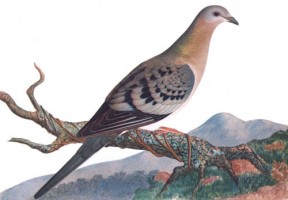
Despite the huge impact and benefit of the pigeon to mankind, in many instances, the pigeon is considered a pest today. The same pigeons which once carried messages from the gods and helped change the outcome of wars are now called the “rats of the sky”. (9) What has happened to the pigeon to cause this drastic change in opinion? Humans took the rock pigeon and through thousands of years of selective breeding and care created a variety of species that had become comfortable with humans and in many cases relied on their care for survival. As more and more pigeons were bred, many ended up in the wild either due to intermingling with wild flocks or forced release by their caretakers who had no more use for their flocks or could no longer care for them. These feral pigeons, who have come to associate humans with everything from food, to shelter, to protection, naturally settled down in the cities where people were abundant. They were able to pick up food littered around the ground or strut around the park and be fed by the people relaxing on benches, in addition to having protection from their natural enemy, birds of prey, who aren’t known to hang out in the city. Overtime, their numbers began to grow and issues began to arise with excessive amounts of pigeon poop causing unsanitary conditions in many big cities. A growing sentiment that the pigeon was pest began to arise that was spurred on by early 1900 newspaper articles suggesting that deadly diseases were spread through pigeon poop. (9) These articles proved to be unfounded and were largely dismissed by the scientific world as a major problem, but the seed had been planted in the minds of the everyday folks.
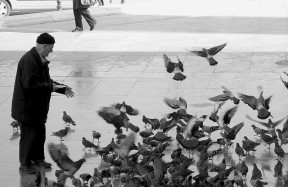
“All the world seems in tune
On a spring afternoon,
When we’re poisoning pigeons in the park.
Every Sunday you’ll see
My sweetheart and me,
As we poison pigeons in the park.
We’ll murder them all amid laughter and merriment,
Except for the few we take home to experiment . . .”
As more and more anti-pigeon propaganda spilled into peoples everyday lives, it is a miracle that pigeons even managed to survive.In a matter of 50 years, the pigeon went from a species that had its own protection laws to one that resulted in new companies whose aim was solely to get rid of them. Feeding pigeons was criminalized in many cities, and that was the nail in the coffin for the species. Today much of the world views the pigeon, specifically the feral varieties, as a pest. (9)

